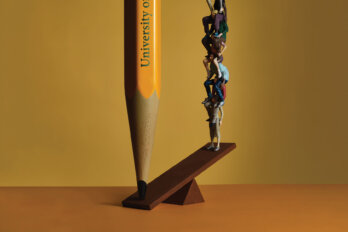In the summer of 2023, as Quebec public school systems faced a shortage of 8,500 teachers, education minister Bernard Drainville made a telling promise. He did not commit to raising salaries, improving working conditions, or finding other ways to attract well-trained professionals. Rather, he insisted that once the school year began, there would be “at least one adult in each classroom.” And he greenlit the hiring of thousands of people without teaching certificates.
This problem is not exclusive to Quebec, where salaries of public school teachers are among the lowest in Canada. Shortages are being reported across the country, including in Ontario, where a mere decade ago so many young people were studying education that new graduates faced 34 percent unemployment rates. To absorb the surplus, the government halved the number of spots in teachers’ colleges and lengthened the program from one year to two, only to now see retirements threaten to outpace new graduates.
According to a 2022 UNESCO report, a lack of trained educators is becoming an issue in Europe and North America, with a turn to underqualified hires becoming a growing trend. In the United States, the Southern Regional School Board found that 9 percent of teachers were uncertified during the 2022/23 school year, nearly double the numbers from three years prior.
The profiles of these uncertified hires range widely. On the high end are those with advanced degrees, including doctorates, who may have post-secondary or other forms of teaching experience but lack the diploma to work in primary and secondary schools. Others are education students called up early to help out. But some of these replacements have neither degrees nor a related background; in Saskatchewan, the minimum requirement for a temporary teaching permit is to be four years out of high school, with further education or a specialized skill merely “preferred.”
Meanwhile, the systemic dependency on uncertified teachers looks like bad news for young people. In Texas, where half of new hires do not have teaching degrees, a study by Jacob Kirksey showed students losing three to four months of learning a year when taught by uncertified teachers with no instructional background. These recruits are also unlikely to stick around, with statewide data revealing that 30 percent quit after the first year, leading to a constant churn of people with little experience.
Likewise troubling are the attitudes that hiring people without proper training encourages. If, in a pinch, anyone with patience and goodwill can teach, what kind of job is it, anyway? Isn’t it mostly a question of liking kids? The result of such thinking is not that it widens the pool of potential teachers but it poisons it. The name of that poison is deprofessionalization.
True to the stereotypes, my mother saw her role as an elementary school teacher as a vocation. She worked for thirty years in the Edmonton public school system, leaving the house at 7:30 a.m. and rarely returning before 6 p.m. Evenings were for marking and lesson plans, and parts of each summer went toward preparing for the new year. Having watched one of her siblings struggle with a learning disability, she gravitated toward special needs. She started her career working with struggling students in the inner city and later moved schools to one in a working-class neighbourhood where she mixed literacy work with teaching grades two or three. “If a kid is behind two grade levels and your mom can’t catch them up, she’s mad at herself,” my father used to say—a carpenter, he switched from construction to maintenance to compensate for her long hours.
But here’s the thing: my mother’s job required a lot more than devotion. She needed a strong grasp of pedagogy and child psychology, as well as the toolkit to accommodate students with wildly different aptitudes and learning styles. She had to manage group dynamics and establish relationships of trust, all while adapting the curriculum for it to be relevant to her particular classroom. Near the end of her career, many of her students came from immigrant families, so she was also at the front line of making them feel part of a community. At stake was the capacity of her students to read, write, add, and subtract.
To meet these challenges, she had a bachelor’s degree in education and a mid-career master’s degree, and she regularly participated in training sessions for new literacy methods. Combining her formal schooling with years of classroom experience, she contributed back into the system, consulting on curriculum revisions and working as a coordinator. She was, in short, a professional.
Treating teaching as a profession, exercised by specialized workers with strict standards for membership, increases the quality of our schools in two ways. Most obviously, trained educators have a stronger foundation to meet the challenges of their job and continue their professional development. At the same time, requiring specific degrees of teachers has a positive effect on remuneration and prestige—which helps attract and retain talented people.
My family had the luck of living in Alberta, where salaries for teachers were long the highest in the nation, and in Edmonton, where a robust public school board has largely outcompeted or absorbed the private sector. By the time my mother retired in 2014, she earned over $100,000 a year. It’s no coincidence, in my mind, that Alberta’s students have consistently scored highly on international measures like the PISA exams—the Programme for International Student Assessment—ranking first in Canada and second worldwide for reading and science in 2022. This system was built under a Progressive Conservative government, evidence that education need not be a partisan affair.
But the viability of a teaching career remains contingent on geography and public policy. Breaking Bad mainstreamed the knowledge that American teachers were poorly paid, as Walter White, the high school chemistry teacher in New Mexico, moonlights as a meth dealer to pay his medical bills. I grew up with less sensational versions of these stories: my mother returned from trips to the US with tales of micromanaged colleagues who made half her salary and worked second jobs. Though conditions vary widely in the American system, the overall pattern is clear. According to UNESCO, teachers in the US make 58 percent of what other professionals with comparable levels of training earn, whereas in Canada, they make slightly above that average.
I bring this up not out of smugness—that problematic sensationalizing of our southern neighbour that lets Canadians feel superior and complacent. Rather, the existence of such a disparity highlights that teaching is vulnerable, perhaps uniquely so, to declining working conditions. In the UK, where public safety nets are far stronger than in the US, teachers are increasingly planning careers abroad to escape long hours and low wages. I was disheartened to learn that Alberta teachers haven’t received a raise in close to a decade, while the salaries of educational assistants, at an average of $26,400 in 2023, have fallen below the poverty line.
It doesn’t help that the profession, especially at the elementary school level, tends to be dominated by women, and therefore subject to the kind of “pink collar” stigma that leads to lower remuneration for nurses, social workers, and even, among surgeons, gynecologists. And out-of-reach housing costs have cascading effects. Last fall, Clint Johnston, the head of the BC Teachers’ Federation, explained to CityNews that even though salaries might look good from the outside, “we have teachers who can’t afford to live in the communities they teach in.”
Pay is only part of the problem. In a 2024 survey, the Canadian Teachers’ Federation found that 80 percent of teachers report struggling to cope with poor working conditions. Among the exacerbating factors are class sizes, inadequate supports for students with disabilities, and all those unpaid hours required to prepare course material. (Retrospectively, some of my mother’s evening shifts could have been built into her actual schedule.)
The result of this overload is burnout. Among new teachers, attrition rates can be alarmingly high, reaching up to 40 percent in the first five years in Canada, the UK, and the US. The baptism-by-fire nature of the job is hard to avoid, as courses are simply easier to deliver the second time around. That said, more could be done to mitigate the situation. Peter Lagacy, head of the New Brunswick Teachers’ Association, has thus called for “proper onboarding and early career support programs” as a key pillar of solving the current crisis.
Instead of tackling these systemic issues, there have been the predictable calls to shorten teacher training. The premier of Nova Scotia has proposed reducing the prerequisite for attending teacher colleges from a full bachelor’s degree to two years of undergraduate study. At Cape Breton University, a new online program leads to a bachelor of education in only eight months. The CBU program is well intentioned: limited to candidates with two years of classroom experience, it provides an avenue for certification for people who have already been thrust into the job.
But such initiatives risk sending the wrong message about the seriousness of the profession. After all, as more than one teacher has complained to me, our government doesn’t go around slashing medical training to combat the chronic shortage of doctors.
What’s really needed are concrete measures to improve working conditions. The membership of the Canadian Teachers’ Federation primarily wants four things: reduced class sizes, more support staff, more dedicated preparation time, and provisions regarding class complexity—a reference to the number of high-needs students in any one group. Addressing these issues requires increased funding, and none of these issues can be resolved with the stroke of a ministerial pen.
Still, if we want young people to flock back into our bachelor of education programs and build careers in our school systems, then being a teacher needs to be a good job, one that combines solid pay with reasonable expectations. Without this, the cycle of shortages is doomed to repeat and emergency hires will remain an ineffective patch on a growing tear in our social fabric.
The end-stage dystopia of the deprofessionalization of teachers is already apparent in some parts of the US. A new online charter school, Unbound Academy, plans to teach kids for two hours a day using learning apps driven by artificial intelligence. Afternoons will be spent on activities like public speaking and group projects.
Initially approved for grades four to eight, this school replaces teachers with “guides,” who provide emotional support and individual coaching, at a ratio of one guide to every thirty-three students. For the moment, these guides still need teaching degrees, at least according to the charter school’s initial application for approval. Yet the idea that machines should be the ones delivering curricula and humans are needed only as cheerleaders shows how low our appreciation of pedagogues has fallen.
I’m not worried that teachers will be replaced en masse by computer programs. A version of that scare already came and went at the post-secondary level, when people were speculating that Massive Open Online Courses would kill the university. Dropout rates for these classes hovered around 90 percent. Like other forms of distance learning, MOOCs have remained a niche element of the educational environment. For too many of us, learning is a social experience, enabled by the structure of a group and the knowledge that an expert is watching you and cares whether you succeed or fail.
Experiments like Unbound Academy are instead depressing evidence of our society’s willingness to invest in technology over people. Stopping the teacher shortage from spreading requires recognizing the value of the profession. Otherwise, we may have “adults in the room” but our children won’t be receiving much in the way of education.




